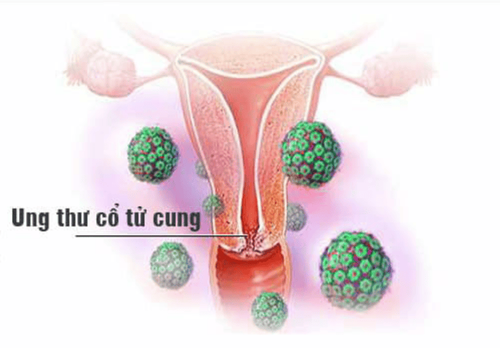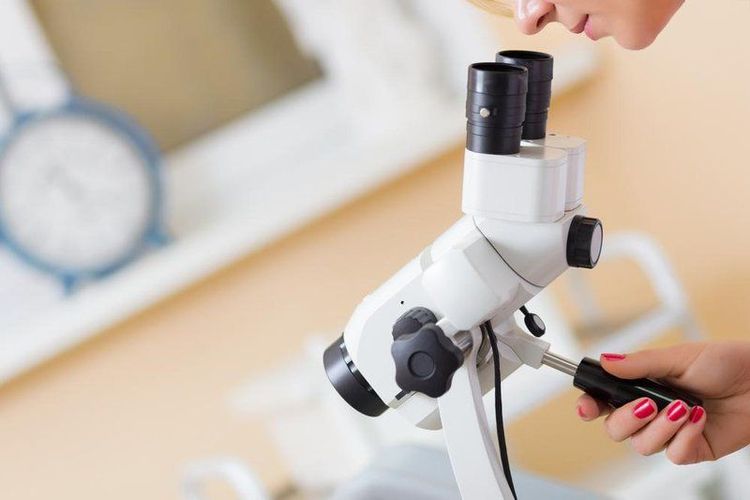This is an automatically translated article.
Article written by Dr. Nguyen Cong Nghia - Head of Obstetrics - Obstetrics Department - Vinmec Times City International General Hospital.
The cervix is the first part of a woman's uterus, located in the vagina, covered with a thin layer of cells. Healthy cells grow, divide, and replace as needed. Cervical cancer occurs when these cells change. They divide faster, uncontrollably, go deep into the lower layer or spread to nearby organs and form cervical cancer.
1. The main cause of cervical cancer
Most cases of cervical cancer are caused by infection with the human papillomavirus (HPV). The HPV virus can enter cells and stimulate cell changes. Certain strains of HPV are strongly associated with cancers of the cervix, vulva, vagina, penis, anus, mouth, and throat. These strains are called high-risk strains that cause cancer. Some strains cause only genital warts and not cancer.
HPV is a virus that is transmitted through sexual contact. HPV is a very common virus, and most women who have normal, regular, and active sex will get an HPV infection in their lifetime. HPV infections often cause no symptoms, and most infections go away on their own. Such short-term HPV infections cause only minimal (low-grade) cell changes. Cells may return to normal once the HPV infection goes away. However, in cases of long-term infection with high-risk strains, cervical cells can change drastically (elevated levels). High-grade cervical cell changes can lead to cancer.
2. How long does it take for cervical cancer to develop?

Ung thư cổ tử cung
Cervical cancer does not grow very quickly, usually takes 3-7 years. During this time, the cells on or around the cervix have abnormal changes. These early changes before the appearance of cancer are called dysplasia or cervical intraepithelial neoplasia (CIN).
Factors that increase the risk of cervical cancer: The biggest risk factor is infection with a type of HPV that has a high risk of causing cancer. The following factors increase the risk of HPV infection, including:
Other risk factors include:
Personal history of cervical, vaginal, or vulvar dysplasia Family history of the disease cervical cancer Smoking Have a sexually transmitted infection, eg chlamydia Immune system disease.
3. How to prevent HPV infection?
Vaccines are currently available to prevent HPV. Current vaccines offer protection against the strains that most commonly cause cancer, pre-cancer, and genital warts. The ideal age for using the HPV vaccine is 11-12 years old, but it is possible to get this vaccine between the ages of 9-26.
4. What are the symptoms of cervical cancer?

ra máu âm đạo bất thường có thể là biểu hiện đầu tiên của ung thư
The first symptoms may be abnormal vaginal bleeding, spotting or increased vaginal discharge. Menstrual bleeding may be heavier than usual, or it may be bleeding after intercourse. As the cancer progresses, signs may include pelvic pain, painful urination, and urinary frequency. Cancer can spread to nearby areas such as the bladder and lymph nodes.
5. How is cervical cancer diagnosed?
Cervical cancer screening is important first of all because it allows cell changes to be detected before they become cancerous. When changes are detected, colposcopy to review the lesion is performed. And finally, cervical tissue will be biopsied and pathologically done to confirm the diagnosis.
Screening -----> Colposcopy -----> Biopsy - GPB
In the next steps, the size of the tumor, the degree of metastasis is determined by physical examination screening, magnetic resonance imaging, CT Scan or PET/CT scan. Based on all this information, the doctor will determine the stage of the cancer. Cervical cancer has stages I through IV. However, cervical cancer also has a stage where the cancer cells have not penetrated or are in situ, called stage 0. At this time, the cells are still only in the top layer of the cervix and have not yet penetrated deeply. down to the lower layers. Cervical cancer detection in this stage has important implications for treatment and prognosis.
6. How to treat and monitor cervical cancer?
Treatments include surgery (total hysterectomy, pelvic lymphadenectomy), chemotherapy and radiation therapy and can be a combination of methods depending on the stage of the cancer. After treatment, your doctor may order a repeat screening test every year to make sure all the cancer cells are gone, even if your cervix has been removed.
7. What is cervical cancer screening and why is it important?
Cervical cancer screening is used to look for changes in the cells of the cervix that can lead to cancer. Screening includes:
Cervical cytology aka Pap smear. HPV testing. The sample collection process is simple and fast. The gynecologist will use a vaginal opener to expose the cervix. The doctor will take the specimen with a tool such as a brush and soak it in a fixative solution. With a Pap smear, your doctor looks for abnormal cells. With HPV testing, genetic analysis is used to find the most common high-risk strains of HPV.
Cervical cancer screening is important because it can detect cell changes before they become cancerous. Women whose cervical cell changes are low may be screened more often to see if the cells can return to normal. Women with high levels of cervical cell changes can have immediate treatment to get rid of the cells.
8. How often should cervical cancer screening and when to stop?

Xét nghiệm Pap smear
Under the age of 21 do not need cervical cancer screening. Between the ages of 21 and 29, a Pap smear should be done every 3 years. Between the ages of 30 and 65, a Pap smear along with an HPV test should be done every 5 years. If an HPV test is not available, a Pap smear should be done every 3 years. After age 65, screening is no longer needed if a woman has no history of moderate or severe cervical cell abnormalities or a history of cervical cancer and, within the past 10 years, has been tested combination is negative. Even if a woman has received the HPV vaccine, the guidelines for screening by age should still be followed.
9. What do abnormal cervical cancer screening results mean?
Many women have abnormal cervical cancer screening results. An abnormal result does not mean cancer, as cervical cell changes can return to normal on their own. If it doesn't return to normal, it can take a number of years for cells with high-grade changes to become cancerous. Cervical cytology results are reported using the term squamous cell intraepithelial lesion (SIL). The report will indicate cytology as ASC-US, LSIL, HSIL, or ASC-H.
If cytology is abnormal on screening, it is best to repeat the Pap smear. Next, colposcopy and lesion biopsy are needed to determine how severe the change is for an accurate diagnosis.
Cervical cancer screening tests are not always completely accurate. Sometimes the results show abnormal cells when in fact they are normal. That is a false positive. Or when the test does not detect abnormal cells when they are present, the result is a false negative. To avoid false-negatives or false-positives, a woman should avoid douching, vaginal douching, sexual intercourse, and using drugs or vaginal hygiene products 2 days before the test. The test should also not be performed while menstruating.
10. How is colposcopy done?

Thiết bị dùng để soi cổ tử cung
Colposcopy is done in the clinic. The gynecologist uses a light source to shine on the cervix and examine it through a magnifying glass. Colposcopy is usually done after cervical cancer screening results show abnormal cell changes. Through colposcopy with special solutions, the gynecologist will look at abnormal lesions, abnormal areas in the cervix and take a biopsy to remove a piece of cervical tissue at the site of injury. Biopsy results are usually reported using the term cervical intraepithelial neoplasia (CIN). CIN 1 is the low-level cytogenetic changes and CIN 3 is the high-level cytogenetic alteration. LSIL in cervical cytology was equivalent to CIN 1, and HSIL was equivalent to CIN 2 and CIN 3. Cervical endothelial cells were also collected for pathology.
11. How is electrocoagulation (LEEP) performed?
If a woman has an abnormal cervical cancer screening result with high-grade cell changes (LSIL or CIN 2, CIN 3), the doctor may perform a cervicectomy with a cauterization ring. electricity (LEEP). This is a very common treatment to remove abnormal cells with a thin, electrically cut loop. This procedure is relatively simple to perform within a few minutes. In addition, many other methods such as apex, cryotherapy or laser can be used.
To minimize the possibility of cervical cancer, sexually active women between the ages of 30 and 49 should have screening tests and early detection of gynecological cancer. However, you can also get screened sooner if you notice something unusual.
For advice and to book an appointment, you can contact Vinmec International General Hospital nationwide HERE.













